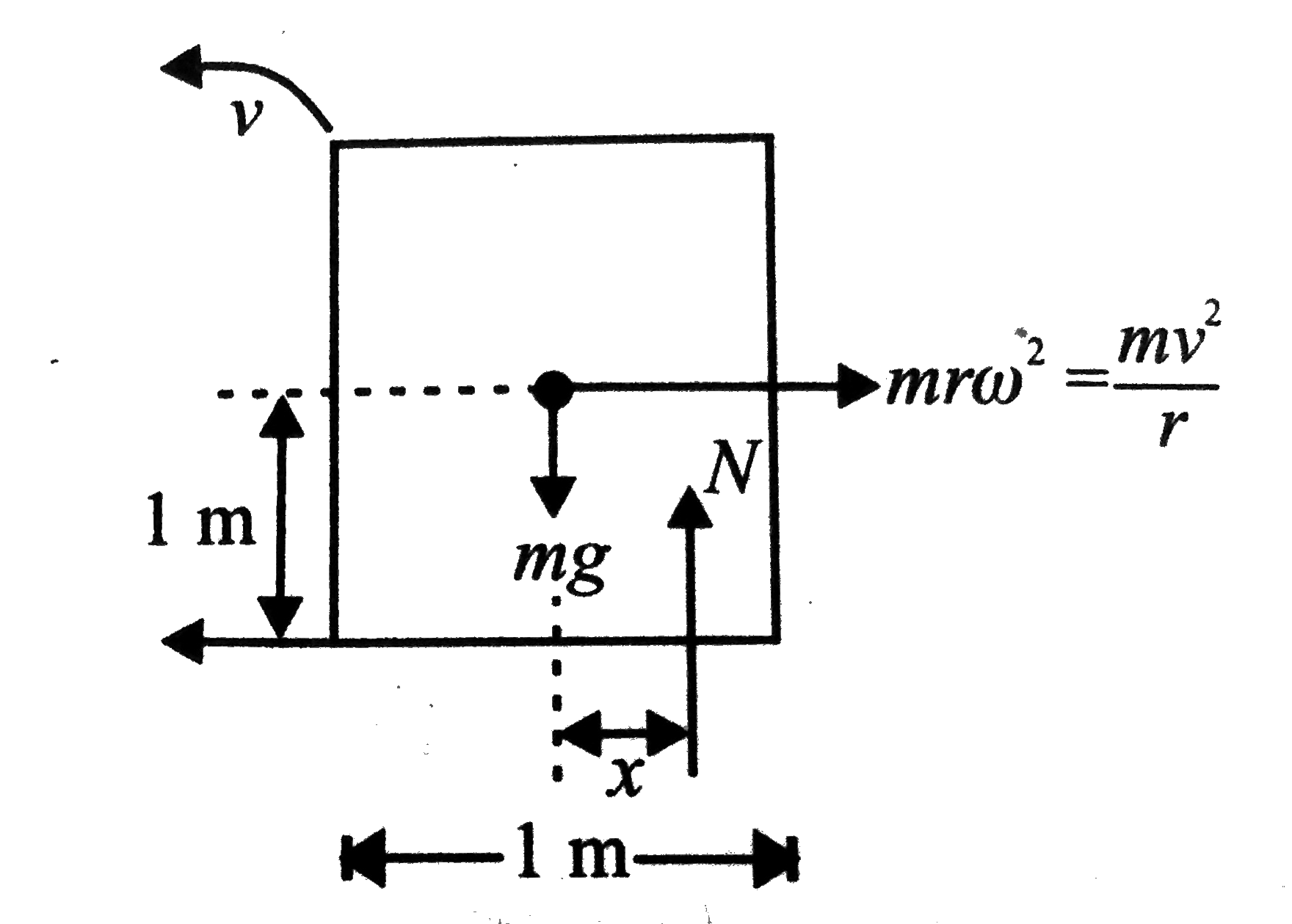A uniform box of height 2m and having a square base of side 1m, weight 150kg, is kept on one end on the floor of a truck. The maximum speed with which the truck can round a curve of radius 20m without causing the block to tip over is (assume that friction is sufficient is no sliding).
15m/s
10m/s
8m/s
depends on the value of coefficient of friction
The correct Answer is:B
The free body diagram of the box w.r.t the truck is as shown in figure.

for vertical equilibrium mg=N
for horizontal equilibrium f=mv2r
For rotation equlibirium f×1=N×x
for no tipping to take place x<(12)m
So, mg×x=mv2R⇒X=v2rg<12⇒v<√rg2=10m/s
Topper's Solved these Questions
- BOOK - CENGAGE PHYSICSCHAPTER - RIGID BODY DYNAMICS 2EXERCISE - Multiple Correct26videos
RIGID BODY DYNAMICS 2
- BOOK - CENGAGE PHYSICSCHAPTER - RIGID BODY DYNAMICS 2EXERCISE - Linked Comprehension71videos
RIGID BODY DYNAMICS 2
- BOOK - CENGAGE PHYSICSCHAPTER - RIGID BODY DYNAMICS 2EXERCISE - Subjective19videos
RIGID BODY DYNAMICS 2
- BOOK - CENGAGE PHYSICSCHAPTER - RIGID BODY DYNAMICS 1EXERCISE - Integer11videos
RIGID BODY DYNAMICS 1
- BOOK - CENGAGE PHYSICSCHAPTER - SOUND WAVES AND DOPPLER EFFECTEXERCISE - Integer16videos
SOUND WAVES AND DOPPLER EFFECT
Similar Questions
The CG of a loaded truck is at a height of 3 m above the ground and the distance between its wheels is 3m. What is the maximum speed with which it can go round a curved road of radius 200 m without turning turtle ?
View SolutionFind the maximum speed at which a car can turn round a curve of 30m radius on a level road if coefficient of friction between the tyress and road is 0.4.Takeg=10m/s2.
View Solution
Knowledge Check
- Question 1 - Select One
The coefficient of friction between the tyres and the road is 0.25. The maximum speed with which a car can be driven round a curve of radius 40 m without skidding is (assume g=10ms−2)
A40ms−1B20ms−1C15ms−1D10ms−1 - Question 2 - Select One
the coefficient of friction between the rubber tyres and the roadway is 0.25 . Find the maximum speed with which a car can be driven round a curve of radius 20 m without skidding
A7m/sB8m/sC9m/sD10m/s - Question 3 - Select One
The coefficient of friction between the tyres and the road is 0.25. The maximum speed with which a car can be driven round a curve of radius 40 m without skidding is (Take g=10ms−2)
A40ms−1B20ms−1C15ms−1D10ms−1
The maximum speed with which a car driven round a curve of radius 18 m without skidding (where ,g=10ms−2 and the coefficient of friction between rubber tyres and the roadway is 0.2)is
View SolutionAssuming the coefficient of friction between the road and tyres of a car to be 0.5, the maximum speed with which the car can move round a curve of 40.0 m radius without slipping, if the road is unbanked, should be
View SolutionFing the maximum speed with which an automobile can round a curve of radius 8 m without slipping of the road is unbanked and he coefficient of friction between the orad an the tyres is 0.8(g=10m/2)
View SolutionAssertion : The maximum speed with which a vehicle can go round a level curve of diameter 20m without skidding is √10m/s given μ=0.1
Reason : If follows from upsilon le sqrt(mu r g) .View SolutionThe coefficient of friction between the tyres and the road is 0.1. The maximum speed with which a cyclist can take a circular turn of radius 3 m without skidding is (Take g=10ms−2)
View Solution

